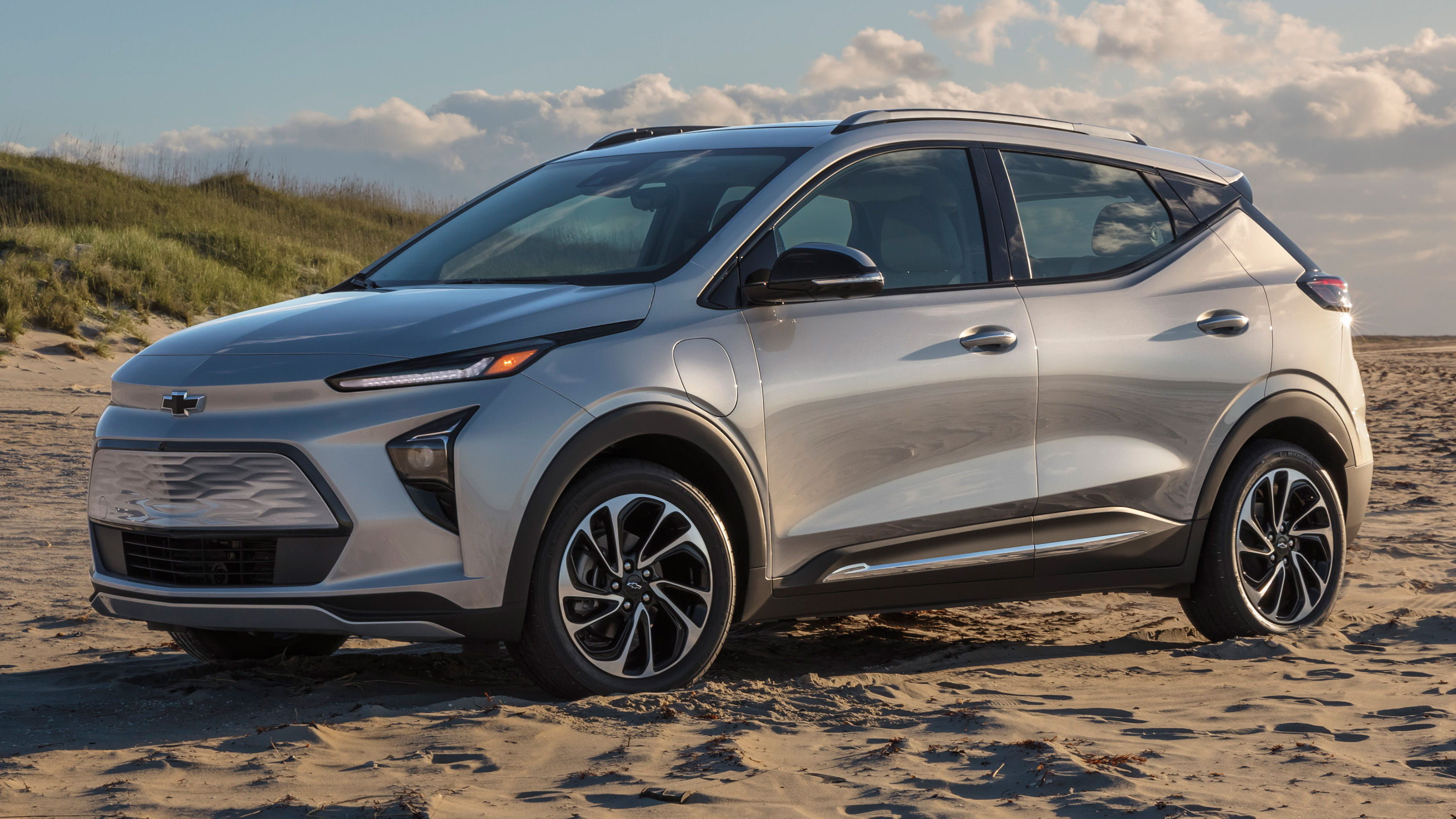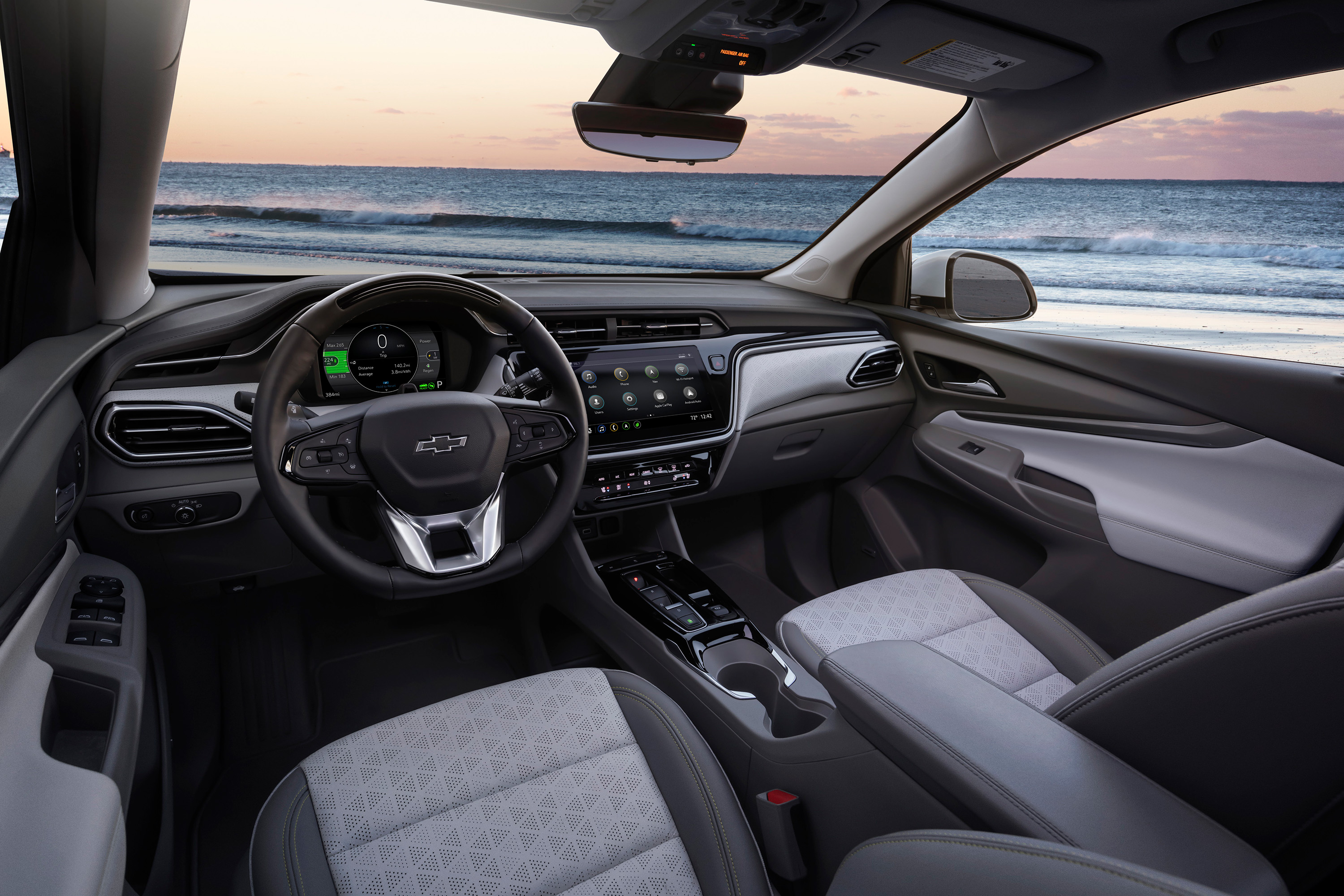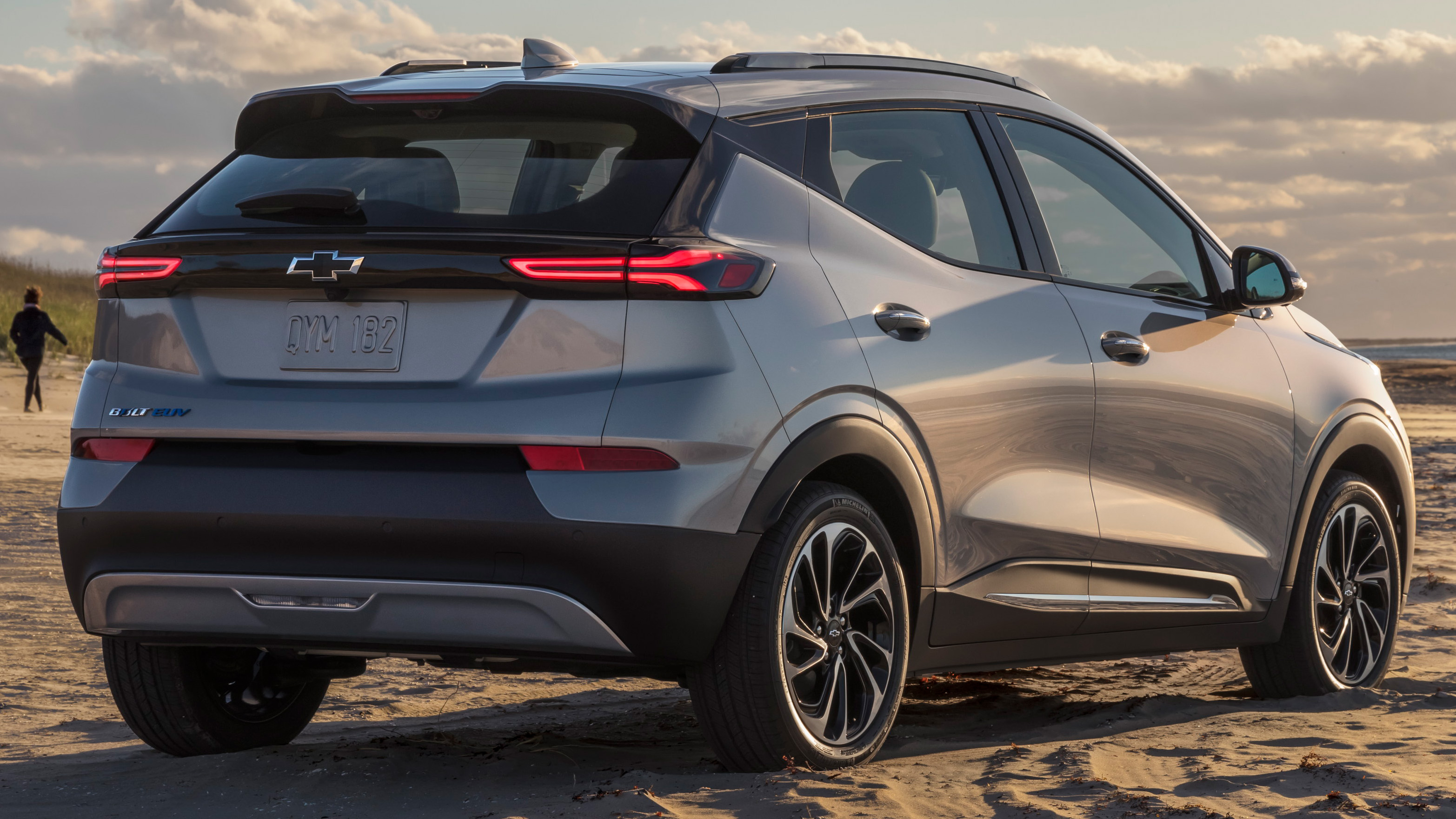2022 Chevrolet Bolt EUV
One Of The Best Bargains In Green Motoring
There’s no denying, the Chevrolet Bolt, when it arrived for 2017, was a true game-changer; delivering real-world range to the masses like no EV before it. It only makes sense that GM would want to spread the love into the SUV category, it just took a little longer than we were expecting, but the Chevrolet Bolt EUV is finally here!
First thing to know about the 2022 Chevrolet Bolt EUV is that it’s essentially just a slightly bigger version of the pioneering Bolt EV. It’s 6.3-inches longer; but more importantly, there’s an additional 3-inches of wheelbase, which provides more space inside.
 Second thing to know is there’s no all-wheel-drive; so, it’s more of an urban utility vehicle, designed with the space and comfort to make daily tasks and weekend errand running easier. So, it’s not a utility intended to get you far off the beaten path.
Second thing to know is there’s no all-wheel-drive; so, it’s more of an urban utility vehicle, designed with the space and comfort to make daily tasks and weekend errand running easier. So, it’s not a utility intended to get you far off the beaten path.
Back when we first tested the Bolt EV, we felt that it was very utility-like; now of course the EUV has made it even more so; though oddly enough, all of that additional room goes strictly to rear seat passenger legroom, as cargo space is actually a tick less in the EUV at 16.3 cubic-ft., down from 16.6. And you can tell rear passenger comfort was the EUV’s priority. While it shares the same basic profile shape, the rear doors are noticeably longer. But, the EUV brings a lot more than just additional rear seat legroom; it arrives with a load of updates, many shared with the Bolt EV.
The hood, as well as both front and rear fascias, have been tweaked slightly, headlamps are updated, and there are new wheel choices. Inside, there’s a new dash with updated infotainment touchscreen that’s now 10.2-inches, as well as a different control layout. While the center console now rises to meet the dash, and replaces the shifter with a row of buttons including a new one for 1-pedal driving. The EUV was also the first non-Cadillac to have SuperCruise available; in top Premier trim naturally. Though it’s still an older generation than currently available to Caddy buyers, so no 1-touch lane changes.
 Premier trim also includes leather seating, surround view camera, and heated steering wheel; though wireless phone charging is standard on all. And due to customer demands, a sunroof is available in the EUV, as part of a Sun and Sound package that includes navigation and Bose premium audio.
Premier trim also includes leather seating, surround view camera, and heated steering wheel; though wireless phone charging is standard on all. And due to customer demands, a sunroof is available in the EUV, as part of a Sun and Sound package that includes navigation and Bose premium audio.
The EUV does share the EV’s powertrain, and as you may have heard, all Bolts were recalled and EUV production was held up due to potential fire concerns with the LG-supplied battery. But, that has since been rectified, and GM added a little range to all Bolts for good measure.
The EUV is officially rated for 247-miles of range, which seems more than reasonable as we were on track for 270 miles before recharging. Its efficiency score is also quite efficient at 29 kWh/100 miles. That 247-mile range is actually 9 miles more than the Bolt EV had when it debuted, and its range has also increased from 238 to 259-miles.
No changes for the front-mounted 150-kW motor, as it outputs the same 200-horsepower and 266 lb-ft. of torque here in the EUV. The EUV’s bigger size equates to a slightly slower 0-60 time of 7.2-seconds; but it still feels quite peppy compared to traditional small ICE crossovers. Still, keeping the accelerator pinned for the entire ¼-mile is not exactly thrilling, as power delivery stays more moderate than aggressive; but the hyper-responsive steering does keep things interesting. Our best pass was 15.7-seconds at 90 miles-per-hour.
 The Bolt EV was an adequately fun car to dart around traffic in, but when pushed to its limits would understeer quite a bit. The longer wheelbase of this EUV doesn’t seem to have improved on that, and there appears to be a little more body roll here too. Not much about the handling experience screams “sport-tuned” but the low-mounted weight of the batteries still lends a solid overall feel, and steering weight was actually quite good. Panic braking stops from 60 averaged a longish 120-feet, with significant nose dive, and lots of ABS pedal pulsing.
The Bolt EV was an adequately fun car to dart around traffic in, but when pushed to its limits would understeer quite a bit. The longer wheelbase of this EUV doesn’t seem to have improved on that, and there appears to be a little more body roll here too. Not much about the handling experience screams “sport-tuned” but the low-mounted weight of the batteries still lends a solid overall feel, and steering weight was actually quite good. Panic braking stops from 60 averaged a longish 120-feet, with significant nose dive, and lots of ABS pedal pulsing.
Things really get interesting when it comes to EUV pricing, with the base LT starting at just $28,195; that’s less than the Bolt cost 5-years ago when it debuted; so naturally Bolt EVs get a corresponding price cut to just $26,595 to start.
The Chevrolet Bolt EUV surely won’t grab as much attention as the Hummers, Mach Es, and Teslas of the EV world. But we think it is still one of the best all-around, everyday EVs out there; and certainly, a clear bargain when it comes to green motoring. And we’re going to need a lot more entry-level EVs like the Bolt EV and this EUV if society is truly serious about wanting an all-electric driving future.
Specifications
- Battery: 65.0-kWh
- Motor Setup: Single Front Mounted 150kW
- Horsepower: 200
- Torque: 266 lb-ft
- 0-60 mph: 7.2 seconds
- 1/4 Mile: 15.7 seconds at 90 mph
- 60-0 Braking: 120 feet (avg)
- EPA: 247 miles
- MW Range: ~ 270 miles
- MW Efficiency: 29 kWh/100 miles
2025 Volkswagen ID. Buzz
Volkswagen Brings Beetlemania Level Of Excitement To Minivan Segment
The duty of upholding Volkswagen’s heritage has most recently been delegated to small legacy car names like Golf and Jetta. But hold on! A much larger, totally modern take on VW’s classic microbus has just buzzed over the horizon— the all-electric ID. Buzz. It’s been at the top of our minds since we first saw the concept back in 2017. Well, it’s finally here, so let’s get our groove into drive!
This 2025 Volkswagen ID. Buzz has indeed created the most buzz around Volkswagen since the Beetle’s return to the U.S. in the late 1990s. We couldn’t drive it anywhere without drawing a crowd. No wonder, just about everyone has a VW Microbus story to tell, and seeing this reimagined version rolling down the street brings back all those memories.
VW really pulled it off as far as we’re concerned, as it looks great without appearing over the top. All the cues are here: Big VW logo front and center, lots of greenhouse including A-pillar windows and mini sliders for the second-row passengers, D-pillar air vents, and two-tone wheels. And while its appearance may be pure retro, its drivetrain is far from it, as the ID. Buzz is all-electric, and unlike the new Beetle, the Buzz does retain the original Microbus’ rear-drive architecture.
Powering those rear wheels is a 210-kW motor drawing juice from a 91-kWh battery for a range of 234 miles; 200-kW max charging will get you to 80% in about 26 minutes. Buyers can add another small 80-kW motor up front for 4motion all-wheel-drive and an increase of total output from 282 to 335 horsepower with a combined 512 lb-ft of torque. It uses the same battery, but range estimates drop just slightly to 231 miles. But while those numbers are modest, we also found them to be quite conservative, as we observed as many as 287 miles available in our all-wheel-drive tester’s gauge display and were on pace for 273 miles in our driving loop.
One throwback theme that may be a turnoff to some is that it’s quite a step up into the Buzz’s front seats, but there’s certainly a commanding view of the road once you climb in. Second row seating can be either a three-place bench or a pair of captain’s chairs, so there’s generous room for seven or six passengers. The captain’s chairs in our Pro S Plus offer good support and very easy access to the third row.
Lots of flexibility too with the option to simply fold the seats or remove them altogether.
With the sliding side doors and a wide opening rear hatch, there’s plenty of access for loading big sport utility amounts of cargo. Lots of flexibility too with the option to simply fold the seats or remove them altogether, and the ability to create a full-length flat floor with a rear cargo shelf that covers some handy removable storage bins. There’s 18.6 cubic-feet of space behind the third row, 75.5 behind the second, and a max of 145.5. That’s more than a Chevrolet Tahoe. For smaller items, there are lots of cubbies throughout the cabin, along with a standard Buzz Box that can be moved to multiple locations.
With a design that prioritizes retro form and modern function over aero efficiency, the 4motion equipped ID. Buzz earns a Fair efficiency rating, using 42-kWh of electricity per 100 miles, and we weren’t sure what to expect at our Mason Dixon test track.
What we found was great torque off the line and drama free launches to 60 in just 5.3 seconds. It was very stable at speed and power delivery stayed steady most of the way down the track until we reached about 90 mph, when it began to taper off just before we finished the quarter-mile in 14.0 seconds flat at 97 mph.
With 1,200-lbs. of battery weight nestled in its 127.5-inch wheelbase, the Buzz felt planted to the pavement through our handling course. There was quite a bit of body roll to deal with, but surprisingly little understeer. In panic braking runs, pedal response was inconsistent, feeling soft at times, pushing back hard at others; but through it all, results were quite good, stopping from 60 in an average of just 108 feet.
Three interior themes are available, this Dune is the brightest, featuring coastal inspired wood optic dash décor, “gray and clay” leatherette surfaces, and a high-mounted central 12.9-inch touchscreen. Pricing starts with a rear-wheel-drive Pro S at $61,545; this Pro S Plus begins at $65,045, add another $4,500 for 4motion, which brings a few extra features along with all-wheel drive.
Retro design with old-school VW charm, modern EV drivetrain, big SUV capacity merged with minivan flexibility; it all comes together in this 2025 Volkswagen ID. Buzz. It’s easily one of the coolest rides of the year and one that will likely keep Volkswagen dealers buzzing for years to come, and that’s something no other people and things mover can say.
Specifications
As Tested
- Motor Setup: Dual-Motor AWD
- Battery Size: 91-kWh
- Horsepower: 335
- Torque: 512 lb-ft
- EPA Range: 231 miles
- 0-60 mph: 5.3 seconds
- 1/4 Mile: 14.0 seconds at 97 mph
- Braking, 60-0: 108 feet
- MW Test Loop: ~ 273 miles













































